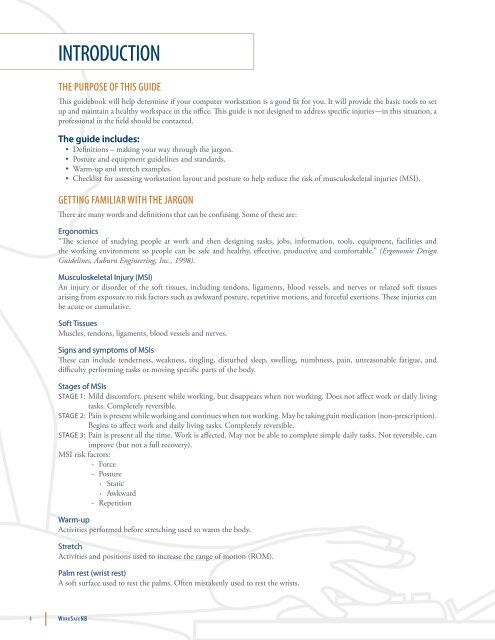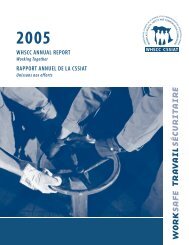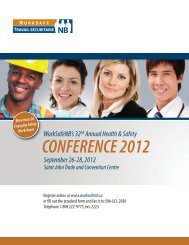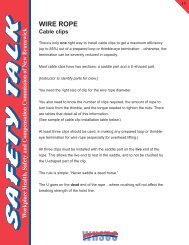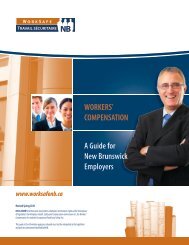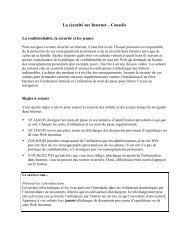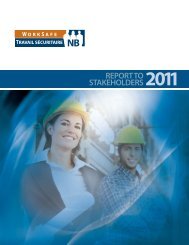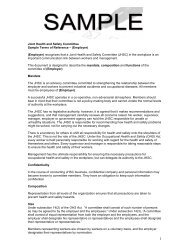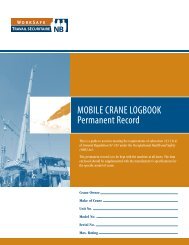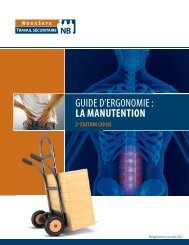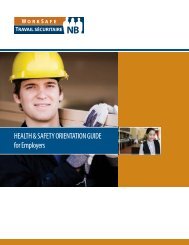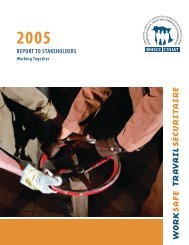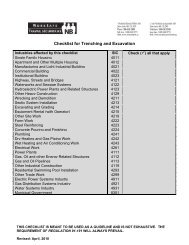OFFICE ERGONOMICS
OFFICE ERGONOMICS
OFFICE ERGONOMICS
You also want an ePaper? Increase the reach of your titles
YUMPU automatically turns print PDFs into web optimized ePapers that Google loves.
intrOductiOn<br />
the PurPOse Of this guide<br />
This guidebook will help determine if your computer workstation is a good fit for you. It will provide the basic tools to set<br />
up and maintain a healthy workspace in the office. This guide is not designed to address specific injuries—in this situation, a<br />
professional in the field should be contacted.<br />
The guide includes:<br />
• Definitions – making your way through the jargon.<br />
• Posture and equipment guidelines and standards.<br />
• Warm-up and stretch examples.<br />
• Checklist for assessing workstation layout and posture to help reduce the risk of musculoskeletal injuries (MSI).<br />
getting famiLiar With the jargOn<br />
There are many words and definitions that can be confusing. Some of these are:<br />
Ergonomics<br />
“The science of studying people at work and then designing tasks, jobs, information, tools, equipment, facilities and<br />
the working environment so people can be safe and healthy, effective, productive and comfortable.” (Ergonomic Design<br />
Guidelines, Auburn Engineering, Inc., 1998).<br />
Musculoskeletal Injury (MSI)<br />
An injury or disorder of the soft tissues, including tendons, ligaments, blood vessels, and nerves or related soft tissues<br />
arising from exposure to risk factors such as awkward posture, repetitive motions, and forceful exertions. These injuries can<br />
be acute or cumulative.<br />
Soft Tissues<br />
Muscles, tendons, ligaments, blood vessels and nerves.<br />
Signs and symptoms of MSIs<br />
These can include tenderness, weakness, tingling, disturbed sleep, swelling, numbness, pain, unreasonable fatigue, and<br />
difficulty performing tasks or moving specific parts of the body.<br />
Stages of MSIs<br />
STAGE 1: Mild discomfort, present while working, but disappears when not working. Does not affect work or daily living<br />
tasks. Completely reversible.<br />
STAGE 2: Pain is present while working and continues when not working. May be taking pain medication (non-prescription).<br />
Begins to affect work and daily living tasks. Completely reversible.<br />
STAGE 3: Pain is present all the time. Work is affected. May not be able to complete simple daily tasks. Not reversible, can<br />
improve (but not a full recovery).<br />
MSI risk factors:<br />
- Force<br />
- Posture<br />
› Static<br />
› Awkward<br />
- Repetition<br />
Warm-up<br />
Activities performed before stretching used to warm the body.<br />
Stretch<br />
Activities and positions used to increase the range of motion (ROM).<br />
Palm rest (wrist rest)<br />
A soft surface used to rest the palms. Often mistakenly used to rest the wrists.<br />
4 Wo r kS a f eNB


